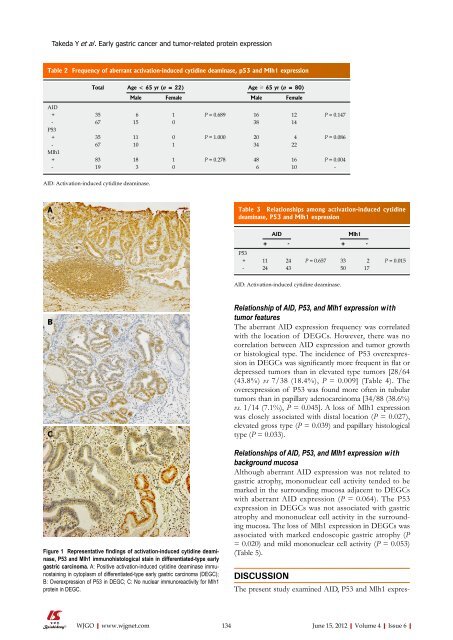6 - World Journal of Gastroenterology
6 - World Journal of Gastroenterology
6 - World Journal of Gastroenterology
You also want an ePaper? Increase the reach of your titles
YUMPU automatically turns print PDFs into web optimized ePapers that Google loves.
Table 2 Frequency <strong>of</strong> aberrant activation-induced cytidine deaminase, p53 and Mlh1 expression<br />
Total Age < 65 yr (n = 22) Age ≥ 65 yr (n = 80)<br />
Male Female Male Female<br />
AID<br />
+ 35 6 1 P = 0.689 16 12 P = 0.147<br />
- 67 15 0 38 14<br />
P53<br />
+ 35 11 0 P = 1.000 20 4 P = 0.086<br />
- 67 10 1 34 22<br />
Mlh1<br />
+ 83 18 1 P = 0.278 48 16 P = 0.004<br />
- 19 3 0 6 10 -<br />
AID: Activation-induced cytidine deaminase.<br />
A<br />
B<br />
C<br />
Takeda Y et al . Early gastric cancer and tumor-related protein expression<br />
Figure 1 Representative findings <strong>of</strong> activation-induced cytidine deaminase,<br />
P53 and Mlh1 immunohistological stain in differentiated-type early<br />
gastric carcinoma. A: Positive activation-induced cytidine deaminase immunostaining<br />
in cytoplasm <strong>of</strong> differentiated-type early gastric carcinoma (DEGC);<br />
B: Overexpression <strong>of</strong> P53 in DEGC; C: No nuclear immunoreactivity for Mlh1<br />
protein in DEGC.<br />
Table 3 Relationships among activation-induced cytidine<br />
deaminase, P53 and Mlh1 expression<br />
Relationship <strong>of</strong> AID, P53, and Mlh1 expression with<br />
tumor features<br />
The aberrant AID expression frequency was correlated<br />
with the location <strong>of</strong> DEGCs. However, there was no<br />
correlation between AID expression and tumor growth<br />
or histological type. The incidence <strong>of</strong> P53 overexpression<br />
in DEGCs was significantly more frequent in flat or<br />
depressed tumors than in elevated type tumors [28/64<br />
(43.8%) vs 7/38 (18.4%), P = 0.009] (Table 4). The<br />
overexpression <strong>of</strong> P53 was found more <strong>of</strong>ten in tubular<br />
tumors than in papillary adenocarcinoma [34/88 (38.6%)<br />
vs. 1/14 (7.1%), P = 0.045]. A loss <strong>of</strong> Mlh1 expression<br />
was closely associated with distal location (P = 0.027),<br />
elevated gross type (P = 0.039) and papillary histological<br />
type (P = 0.033).<br />
Relationships <strong>of</strong> AID, P53, and Mlh1 expression with<br />
background mucosa<br />
Although aberrant AID expression was not related to<br />
gastric atrophy, mononuclear cell activity tended to be<br />
marked in the surrounding mucosa adjacent to DEGCs<br />
with aberrant AID expression (P = 0.064). The P53<br />
expression in DEGCs was not associated with gastric<br />
atrophy and mononuclear cell activity in the surrounding<br />
mucosa. The loss <strong>of</strong> Mlh1 expression in DEGCs was<br />
associated with marked endoscopic gastric atrophy (P<br />
= 0.020) and mild mononuclear cell activity (P = 0.053)<br />
(Table 5).<br />
DISCUSSION<br />
AID Mlh1<br />
+ - + -<br />
P53<br />
+ 11 24 P = 0.657 33 2 P = 0.015<br />
- 24 43 50 17<br />
AID: Activation-induced cytidine deaminase.<br />
The present study examined AID, P53 and Mlh1 expres-<br />
WJGO|www.wjgnet.com 134<br />
June 15, 2012|Volume 4|Issue 6|

















